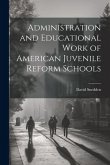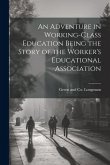- Broschiertes Buch
- Merkliste
- Auf die Merkliste
- Bewerten Bewerten
- Teilen
- Produkt teilen
- Produkterinnerung
- Produkterinnerung
American Educational History: School, Society, and the Common Good is an up-to-date, contemporary examination of historical trends that have helped shape schools and education in the United States. Author William H. Jeynes places a strong emphasis on recent history, most notably post-World War II issues such as the role of technology, the standards movement, affirmative action, bilingual education, undocumented immigrants, school choice, and much more!
Andere Kunden interessierten sich auch für
![Administration and Educational Work of American Juvenile Reform Schools Administration and Educational Work of American Juvenile Reform Schools]() David SneddenAdministration and Educational Work of American Juvenile Reform Schools24,99 €
David SneddenAdministration and Educational Work of American Juvenile Reform Schools24,99 €![An Outline of the History of Educational Theories in England An Outline of the History of Educational Theories in England]() Harry Thiselton MarkAn Outline of the History of Educational Theories in England21,99 €
Harry Thiselton MarkAn Outline of the History of Educational Theories in England21,99 €![A Study of the Moral and Religious Elements in American Secondary Education Up to 1800 A Study of the Moral and Religious Elements in American Secondary Education Up to 1800]() Adrian Augustus HoltzA Study of the Moral and Religious Elements in American Secondary Education Up to 180019,99 €
Adrian Augustus HoltzA Study of the Moral and Religious Elements in American Secondary Education Up to 180019,99 €![Contributions to American Educational History: No. 10 Higher Education in Indiana Contributions to American Educational History: No. 10 Higher Education in Indiana]() Herbert Baxter AdamsContributions to American Educational History: No. 10 Higher Education in Indiana26,99 €
Herbert Baxter AdamsContributions to American Educational History: No. 10 Higher Education in Indiana26,99 €![History and Status of American Physical Education and Educational Sport History and Status of American Physical Education and Educational Sport]() Earle F. Zeigler LL. D D. Sc.History and Status of American Physical Education and Educational Sport31,99 €
Earle F. Zeigler LL. D D. Sc.History and Status of American Physical Education and Educational Sport31,99 €![An Adventure in Working-Class Education Being the Story of the Worker's Educational Association An Adventure in Working-Class Education Being the Story of the Worker's Educational Association]() An Adventure in Working-Class Education Being the Story of the Worker's Educational Association21,99 €
An Adventure in Working-Class Education Being the Story of the Worker's Educational Association21,99 €![The Education of American Girls, Considered in a Series of Essays The Education of American Girls, Considered in a Series of Essays]() Anna C. BrackettThe Education of American Girls, Considered in a Series of Essays30,99 €
Anna C. BrackettThe Education of American Girls, Considered in a Series of Essays30,99 €-
-
-
American Educational History: School, Society, and the Common Good is an up-to-date, contemporary examination of historical trends that have helped shape schools and education in the United States. Author William H. Jeynes places a strong emphasis on recent history, most notably post-World War II issues such as the role of technology, the standards movement, affirmative action, bilingual education, undocumented immigrants, school choice, and much more!
Hinweis: Dieser Artikel kann nur an eine deutsche Lieferadresse ausgeliefert werden.
Hinweis: Dieser Artikel kann nur an eine deutsche Lieferadresse ausgeliefert werden.
Produktdetails
- Produktdetails
- Verlag: Sage Publications, Inc
- Seitenzahl: 496
- Erscheinungstermin: 18. Januar 2007
- Englisch
- Abmessung: 235mm x 191mm x 27mm
- Gewicht: 917g
- ISBN-13: 9781412914215
- ISBN-10: 1412914213
- Artikelnr.: 22205744
- Herstellerkennzeichnung
- Libri GmbH
- Europaallee 1
- 36244 Bad Hersfeld
- gpsr@libri.de
- Verlag: Sage Publications, Inc
- Seitenzahl: 496
- Erscheinungstermin: 18. Januar 2007
- Englisch
- Abmessung: 235mm x 191mm x 27mm
- Gewicht: 917g
- ISBN-13: 9781412914215
- ISBN-10: 1412914213
- Artikelnr.: 22205744
- Herstellerkennzeichnung
- Libri GmbH
- Europaallee 1
- 36244 Bad Hersfeld
- gpsr@libri.de
1. The Colonial Experience, 1607-1776 The Colonists at Jamestown The Spanish Colonists in Florida The Pilgrims/Puritans Education Contributions of Other Groups The Extent of the Puritan Contribution The Growth of Higher Education Before the Revolutionary War Relations Between the Puritans and Native Americans Deteriorate Conclusion 2. The Effects of the Revolutionary War Era on American Education Distinguishing a Truly American System of Education The Rise of Charity Schools Supplements to Charity Schools Free Schools and African Americans The Charity School Movement Becomes Nationwide The Decline of the Charity School System The College Level Conclusion 3. The Early Political Debates and Their Effect on the American Education System The Views of the Democratic Republics and the Federalists The Presidents and Educational Leaders from Each Political Party How the Victories By Democratic-Republicans Influenced American Education Conclusion 4. Education, African Americans, and Slavery African American Education in the North The Education of African Americans in the South Changing American Education Forever: Education and Events Leading Up to the Election of Lincoln and Liberation for the Slaves American Northern Heroes Conclusion 5. The Education of Women and Native Americans, Latinos, and Asian Americans The Education of Women The Education of Native Americans The Education of Asian Americans The Education of Latinos Conclusion 6. The Widespread Growth of the Common School & Higher Education Horace Mann and the Rise of the Common Schools Mann
s Arguments that Common Schools Would Promote the Common Good Resistance to the Public Schools Contemporaries of Horace Mann in the Common School Movement The Civil War and the Common School Movement The Growth of Higher Education During the First Half of the 1800s Where State Universities Grew and Where They Did Not The Growth of State Colleges in Other States Conclusion 7. The Effects of the Events During and Between the Civil War and World War I The Impact of the Civil War The Impact of the Post-Civil War Period The Debate Over African American Education Increased Immigration Social Role of the School Land Grant Colleges Major Events in the Post-Civil War Period Events Leading Up to and Including World War I Conclusion 8. The Liberal Philosophy of Education As Distinguished from Conservatism The Schools of Educational Philosophy The Educational Philosophy of John Dewey Other Liberal Reformers Moderate Liberals Moderates Neo-Conservatives Conclusion 9. The Great Depression and the Long-Term Effects on World War II and the Cold War on American Education The Educational Challenges of the Great Depression (1929-1941) The Impact of World War II on Education The Rise of Community Colleges The Cold War Conclusion 10. The Civil Rights Movement and Federal Involvement in Educational Policy Truman
s Contribution The Pursuit of Civil Rights Legislation in the Courts Brown Helps Build Momentum for the Civil Rights Movement Expanding the Reach of the Civil Rights Movement: Affirmative Action Expanding the Reach of the Civil Rights Movement: Bilingual Eduation Conclusion 11. The Turbulence of the 1960s The Vietnam War and Student Activism Civil Rights and Education The New York City Teacher
s Strike The Primacy of New Educational Thought The Removal of Prayer from the Schools Sex Education Conclusion 12. The Rise of Public Criticism of Education Basic Arguments Addressing the Data What Does the College Board
s Assessment Mean? Advances in Public Education During the 1963-1980 Period How Did the Rising Criticism of Education Influence Schools? Conclusion 13. The Rise of Multiculturalism & Other Issues The Rise of Multiculturalism The Success of Multicultural Curricula The Debate About Multiculturalism The Future of Multiculturalism Vocational Education Education for the Children with Special Needs or Disabilities Conclusion 14. Educational Reform Under the Republicans and Democrats Reforms Under the Republicans Reagan, Bush, and George W. Bush Democratic Party Reforms Under Bill Clinton The Political Atmosphere Today Conclusion 15. Other Recent Educational Issues and Reforms Equalization of School Expenditures School Shootings School Uniforms The Influence of the Family Learning from Foreign Systems of Education Technology in the Schools Homeschooling Conclusion
s Arguments that Common Schools Would Promote the Common Good Resistance to the Public Schools Contemporaries of Horace Mann in the Common School Movement The Civil War and the Common School Movement The Growth of Higher Education During the First Half of the 1800s Where State Universities Grew and Where They Did Not The Growth of State Colleges in Other States Conclusion 7. The Effects of the Events During and Between the Civil War and World War I The Impact of the Civil War The Impact of the Post-Civil War Period The Debate Over African American Education Increased Immigration Social Role of the School Land Grant Colleges Major Events in the Post-Civil War Period Events Leading Up to and Including World War I Conclusion 8. The Liberal Philosophy of Education As Distinguished from Conservatism The Schools of Educational Philosophy The Educational Philosophy of John Dewey Other Liberal Reformers Moderate Liberals Moderates Neo-Conservatives Conclusion 9. The Great Depression and the Long-Term Effects on World War II and the Cold War on American Education The Educational Challenges of the Great Depression (1929-1941) The Impact of World War II on Education The Rise of Community Colleges The Cold War Conclusion 10. The Civil Rights Movement and Federal Involvement in Educational Policy Truman
s Contribution The Pursuit of Civil Rights Legislation in the Courts Brown Helps Build Momentum for the Civil Rights Movement Expanding the Reach of the Civil Rights Movement: Affirmative Action Expanding the Reach of the Civil Rights Movement: Bilingual Eduation Conclusion 11. The Turbulence of the 1960s The Vietnam War and Student Activism Civil Rights and Education The New York City Teacher
s Strike The Primacy of New Educational Thought The Removal of Prayer from the Schools Sex Education Conclusion 12. The Rise of Public Criticism of Education Basic Arguments Addressing the Data What Does the College Board
s Assessment Mean? Advances in Public Education During the 1963-1980 Period How Did the Rising Criticism of Education Influence Schools? Conclusion 13. The Rise of Multiculturalism & Other Issues The Rise of Multiculturalism The Success of Multicultural Curricula The Debate About Multiculturalism The Future of Multiculturalism Vocational Education Education for the Children with Special Needs or Disabilities Conclusion 14. Educational Reform Under the Republicans and Democrats Reforms Under the Republicans Reagan, Bush, and George W. Bush Democratic Party Reforms Under Bill Clinton The Political Atmosphere Today Conclusion 15. Other Recent Educational Issues and Reforms Equalization of School Expenditures School Shootings School Uniforms The Influence of the Family Learning from Foreign Systems of Education Technology in the Schools Homeschooling Conclusion
1. The Colonial Experience, 1607-1776 The Colonists at Jamestown The Spanish Colonists in Florida The Pilgrims/Puritans Education Contributions of Other Groups The Extent of the Puritan Contribution The Growth of Higher Education Before the Revolutionary War Relations Between the Puritans and Native Americans Deteriorate Conclusion 2. The Effects of the Revolutionary War Era on American Education Distinguishing a Truly American System of Education The Rise of Charity Schools Supplements to Charity Schools Free Schools and African Americans The Charity School Movement Becomes Nationwide The Decline of the Charity School System The College Level Conclusion 3. The Early Political Debates and Their Effect on the American Education System The Views of the Democratic Republics and the Federalists The Presidents and Educational Leaders from Each Political Party How the Victories By Democratic-Republicans Influenced American Education Conclusion 4. Education, African Americans, and Slavery African American Education in the North The Education of African Americans in the South Changing American Education Forever: Education and Events Leading Up to the Election of Lincoln and Liberation for the Slaves American Northern Heroes Conclusion 5. The Education of Women and Native Americans, Latinos, and Asian Americans The Education of Women The Education of Native Americans The Education of Asian Americans The Education of Latinos Conclusion 6. The Widespread Growth of the Common School & Higher Education Horace Mann and the Rise of the Common Schools Mann
s Arguments that Common Schools Would Promote the Common Good Resistance to the Public Schools Contemporaries of Horace Mann in the Common School Movement The Civil War and the Common School Movement The Growth of Higher Education During the First Half of the 1800s Where State Universities Grew and Where They Did Not The Growth of State Colleges in Other States Conclusion 7. The Effects of the Events During and Between the Civil War and World War I The Impact of the Civil War The Impact of the Post-Civil War Period The Debate Over African American Education Increased Immigration Social Role of the School Land Grant Colleges Major Events in the Post-Civil War Period Events Leading Up to and Including World War I Conclusion 8. The Liberal Philosophy of Education As Distinguished from Conservatism The Schools of Educational Philosophy The Educational Philosophy of John Dewey Other Liberal Reformers Moderate Liberals Moderates Neo-Conservatives Conclusion 9. The Great Depression and the Long-Term Effects on World War II and the Cold War on American Education The Educational Challenges of the Great Depression (1929-1941) The Impact of World War II on Education The Rise of Community Colleges The Cold War Conclusion 10. The Civil Rights Movement and Federal Involvement in Educational Policy Truman
s Contribution The Pursuit of Civil Rights Legislation in the Courts Brown Helps Build Momentum for the Civil Rights Movement Expanding the Reach of the Civil Rights Movement: Affirmative Action Expanding the Reach of the Civil Rights Movement: Bilingual Eduation Conclusion 11. The Turbulence of the 1960s The Vietnam War and Student Activism Civil Rights and Education The New York City Teacher
s Strike The Primacy of New Educational Thought The Removal of Prayer from the Schools Sex Education Conclusion 12. The Rise of Public Criticism of Education Basic Arguments Addressing the Data What Does the College Board
s Assessment Mean? Advances in Public Education During the 1963-1980 Period How Did the Rising Criticism of Education Influence Schools? Conclusion 13. The Rise of Multiculturalism & Other Issues The Rise of Multiculturalism The Success of Multicultural Curricula The Debate About Multiculturalism The Future of Multiculturalism Vocational Education Education for the Children with Special Needs or Disabilities Conclusion 14. Educational Reform Under the Republicans and Democrats Reforms Under the Republicans Reagan, Bush, and George W. Bush Democratic Party Reforms Under Bill Clinton The Political Atmosphere Today Conclusion 15. Other Recent Educational Issues and Reforms Equalization of School Expenditures School Shootings School Uniforms The Influence of the Family Learning from Foreign Systems of Education Technology in the Schools Homeschooling Conclusion
s Arguments that Common Schools Would Promote the Common Good Resistance to the Public Schools Contemporaries of Horace Mann in the Common School Movement The Civil War and the Common School Movement The Growth of Higher Education During the First Half of the 1800s Where State Universities Grew and Where They Did Not The Growth of State Colleges in Other States Conclusion 7. The Effects of the Events During and Between the Civil War and World War I The Impact of the Civil War The Impact of the Post-Civil War Period The Debate Over African American Education Increased Immigration Social Role of the School Land Grant Colleges Major Events in the Post-Civil War Period Events Leading Up to and Including World War I Conclusion 8. The Liberal Philosophy of Education As Distinguished from Conservatism The Schools of Educational Philosophy The Educational Philosophy of John Dewey Other Liberal Reformers Moderate Liberals Moderates Neo-Conservatives Conclusion 9. The Great Depression and the Long-Term Effects on World War II and the Cold War on American Education The Educational Challenges of the Great Depression (1929-1941) The Impact of World War II on Education The Rise of Community Colleges The Cold War Conclusion 10. The Civil Rights Movement and Federal Involvement in Educational Policy Truman
s Contribution The Pursuit of Civil Rights Legislation in the Courts Brown Helps Build Momentum for the Civil Rights Movement Expanding the Reach of the Civil Rights Movement: Affirmative Action Expanding the Reach of the Civil Rights Movement: Bilingual Eduation Conclusion 11. The Turbulence of the 1960s The Vietnam War and Student Activism Civil Rights and Education The New York City Teacher
s Strike The Primacy of New Educational Thought The Removal of Prayer from the Schools Sex Education Conclusion 12. The Rise of Public Criticism of Education Basic Arguments Addressing the Data What Does the College Board
s Assessment Mean? Advances in Public Education During the 1963-1980 Period How Did the Rising Criticism of Education Influence Schools? Conclusion 13. The Rise of Multiculturalism & Other Issues The Rise of Multiculturalism The Success of Multicultural Curricula The Debate About Multiculturalism The Future of Multiculturalism Vocational Education Education for the Children with Special Needs or Disabilities Conclusion 14. Educational Reform Under the Republicans and Democrats Reforms Under the Republicans Reagan, Bush, and George W. Bush Democratic Party Reforms Under Bill Clinton The Political Atmosphere Today Conclusion 15. Other Recent Educational Issues and Reforms Equalization of School Expenditures School Shootings School Uniforms The Influence of the Family Learning from Foreign Systems of Education Technology in the Schools Homeschooling Conclusion








